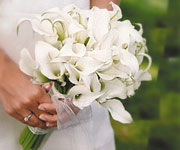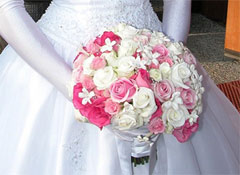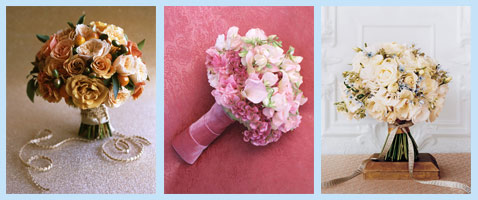Bridal Bouquet Basics
 The Bridal Bouquet – the small (or not so small) bundle of flowers that is like a floral centerpiece for the bride, a posy to pose with during pictures and add a touch of color to the total white that is a bride’s outfit, we’ll tell you about its history and help you choose the color and style for your Jewish wedding.
The Bridal Bouquet – the small (or not so small) bundle of flowers that is like a floral centerpiece for the bride, a posy to pose with during pictures and add a touch of color to the total white that is a bride’s outfit, we’ll tell you about its history and help you choose the color and style for your Jewish wedding.
Why does a Bride need a Bouquet?
 Perhaps a you find this to be a strange question. After all the bridal bouquet is as common at a wedding as the white wedding gown. (Which brings us to another question: why should the wedding dress be white? But that would have to wait for another time.) However, it wasn’t always so that a bride was clutching onto a floral arrangement. As far back as weddings go, however, bridal hands were holding some sort of an object. In a Jewish wedding, brides used to hold a candle; a role reserved now for the parents. The modern history of the wedding bouquet begins with Queen Victoria and her posy at her wedding to Prince Albert in 1840.
Perhaps a you find this to be a strange question. After all the bridal bouquet is as common at a wedding as the white wedding gown. (Which brings us to another question: why should the wedding dress be white? But that would have to wait for another time.) However, it wasn’t always so that a bride was clutching onto a floral arrangement. As far back as weddings go, however, bridal hands were holding some sort of an object. In a Jewish wedding, brides used to hold a candle; a role reserved now for the parents. The modern history of the wedding bouquet begins with Queen Victoria and her posy at her wedding to Prince Albert in 1840.
In Victorian times, flowers were also assigned symbolic meanings, and were selected for the bouquet not merely by the merits of their aesthetics. Thankfully, we don’t have to contemplate our flowers beyond their outer appearance. When choosing your bouquet you’ll need to consider the shape and the flowers of your choice, as well as how it would look in conjunction with the style of your wedding gown and your wedding portraits.
The Posy

images: MarthaStewart.com
The posy is a small, circular cluster of flowers that probably is the most common shape of the bridal bouquet. The posy is fashioned in two ways: ‘Hand-tied’ and ‘Fully wired’.
Hand-Tied
Also know as ‘natural stems’, hand tied posies are made showing the natural stems of the flowers that are tied tightly together. When holding such a bouquet, the bride holds on to the stems of the flowers. The stems can also be wrapped in tulle, velvet trim or pinned with pearl-pins. Hand-tied and wrapped bouquets are the current trend.
Wired
A wired posy has its flowers fastened by florists’ wire and neatly placed into a plastic, easy to hold handle. When using roses, it is more common to have them wired. The wired bouquet gives a more polished symmetrical look. Biedermeier is a variation of the wired bouquet, where the flowers are arranged in circular rows of flowers – each row with its own color.
Cascade Bouquet
There are a few variations of the cascade bouquet, also known as a shower bouquet. All these bouquets have the flowers flow out beyond the main portion of the bouquet. Sometimes the cascade will take the form of a teardrop – the bottom of the bouquet will come to a point, and sometimes of a waterfall – the width of the bottom not much smaller than at the top. The flowing cascade bouquets are very elegant and feminine and work well with a vintage looking wedding gown. A note of warning: the cascade when done right can look glamorous without looking overdone. However, often times it becomes large and overstuffed. Browse online or through magazines to get better acqainted with the multiple variations of the cascade.
Final Note
In general, when selecting your bridal bouquet, bring your florist cut-outs and print-outs of what you find striking. Almost any florist can reproduce a bouquet based on its picture. Attention to detail and subtle taste, however, will usually be found at a more upscale floral shop – the price will reflect the quality accordingly.
